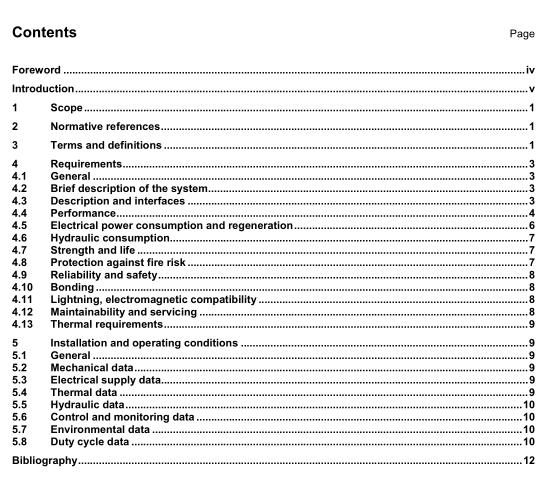ISO 22072 pdf download

ISO 22072 pdf download Aerospace — Electrohydrostatic actuator (EHA) — Characteristics to be defined in procurement specifications
4.4.4Servo-loop dynamic performance and stability
The following shall be specified either as the complete servo-oop requirement or as the part allocated to theactuator, taking into account data under 5.6:
maximum no-load rate,including,as applicable (in terms of percentage),command amplitude andfrequency;
maximum no-load acceleration due to motor voltage/current saturation, including, as applicable (in termsof percentage), command amplitude and frequency;
maximum regenerative power;
bandwidth of the position servo-loop,expressed in terms of amplitude ratio and phase lag in thefrequency range, for defined amplitudes and loads;
maximum acceptable overshoot to a step input of specified amplitude;
minimum acceptable stability margins of the position servo-loop and any inner control loops (ex: motorspeedy;
acceptable speed oscillation, characterized by frequency and amplitude (motor and pump may generatetorque ripple);
response time of the possible anti-back-driving device;
acceptable limit cycle (an anti-back-driving device may generate a limit cycle);
dynamic stiffness;
force fighting. depending on system configuration;
—possible allowed performance degradation under extreme conditions.4.4.5Operation under failure conditions
Desired behaviour in the event of supplylcontrol computerlelectronic module or other failures shall bespecified,including transient performance.
Possible specific EHA failure modes shall be addressed (e.g. motor/pump possible over speed when backe-driven by the load).
4.5Electrical power consumption and regeneration4.5.1Consumption
Power factor and in-rush current, steady-state power consumption with no movement,as a function of theapplied load, and peak consumption in the course of typical manoeuvres, under specified supply and ambientconditions,shall be specified.
4.5.2Regenerative energy
Under aiding load operation or deceleration,the motor generates electrical energy. The way and theconditions under which this energy is to be handled, either dissipated locally or put back on the aircraft powerbus, shall be specified.
4.6Hydraulic consumption
Allowable fluid loss, allowable refill interval, and life of fluid shall be specified.4.7Strength and life
4.7.1Static strength
Static strength is defined by the following.
a) Limit load (without permanent deformation or leakage): maximum driving or resisting force capability of
the unit, with account taken of any force limitation function possibly incorporated. In the case where ananti-back-driving device is included, the maximum holding force may define this limit load.
b) Ultimate load (without rupture): ×1,5 limit load.
c)Proof pressure (without permanent deformation or leakage): x1,5 maximum permanent pressure
associated with the limit load or ×1,5 maximum operating pressure.For lines only submitted to the fluidcompensator pressure: ×1,5 maximum fluid compensator pressure.
d) Ultimate pressure (without rupture): x2 maximum permanent pressure associated with the limit load or x2
maximum operating pressure.For lines only submitted to the fluid compensator pressure: x2 maximumfluid compensator pressure.
NOTE The above factors are recommended values. Other sizing cases, not specfic to EHA and depending on thesystem configuration, may apply.
e) lf the actuator is connected to a hydraulic system, in order to avoid the need to service for example, the
usual hydraulic system sizing conditions shall apply to all parts exposed to the system pressures.
f) The EHA shall be able to withstand any bottoming loads corresponding to the design conditions of the
control system.
4.7.2Fatigue and wear life
The fatigue life under external loads,acceleration,and pressure transients possibly generated by theoperation of the unit is associated with the absence of crack initiation. Generally the fatigue life of the actuatoris equivalent to the structural life of the vehicle.Appropriate scatter factors shall be used.
lf the actuator is connected to a hydraulic system, the usual hydraulic system pressure impulse requirements,SAE ARP1383B or specific requirements shall apply to all parts exposed to the system pressures.
The wear life under external loads, strokes,velocities, acceleration, and combinations thereof, is associatedwith the absence of component wear resulting in unacceptable degradation of performance. Generally, thewear life of the actuator is equivalent to the structural life of the vehicle. Appropriate scatter factors shall beused.









